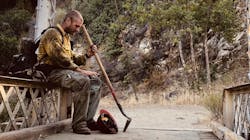Official: Viral Wildfire Photo Captures CA Hotshots' Fatigue
By Amy Graff
Source SFGate, San Francisco
At the beginning of what's expected to be a record-breaking wildfire season in California, a photo of a firefighter who has battled flames in Big Sur's Willow Fire is becoming a symbol of the foreboding 2021 wildfire season.
Justin Grunewald, his face and clothing covered in ash, appears exhausted, resting for what was likely a brief moment amid a stream of grueling days.
Grunewald is what's known as a hotshot, a member of a U.S. Forest crew trained to battle wildfires under the most dangerous conditions. As a captain with the Mill Creek hotshots, he has been hiking miles daily to access the remote Willow Fire that has grown to nearly 3,000 acres in a week.
"In the wildland arena, the hotshots are the All Stars," said Steve Rasmussen, a spokesperson for the Willow Incident. " The Los Padres National Forest where the Willow Fire is … it's very steep, rugged terrain, inaccessible in many parts. For several days now, hot shot crews were flown into remote areas to access the fire and they're also hiking in. It's hot, it's dry, it's steep, it's rugged, it's dangerous and they train for it."
The image of Grunewald was posted on Twitter by the Los Padres National Forest where the fire started, and it was shared along with the message, "After a week of relentless work by firefighters the containment is now at 26% with no new growth. The acreage remains unchanged."
Many left messages in the comments, thanking firefighters and remarking on the difficulty of the job.
"Exhausted! So many thoughts and emotions running through his body. Yet, he'll rise before the sun day after day only to do it all over again without complaining," wrote one.
"We think we know how hard they work. But I am sure that what we imagine, doesn't even come close to reality. Much gratitude to our firefighters!" shared another.
Amanda Munsey, who is part of a team managing the incident and sharing updates with the public, said their office was struggling to get images of the fire due to the remote location.
"At the morning fire meeting, we asked the firefighters if they had any photos because the fire is so hard to access," Munsey said. "That day we knew there were going to be hotshots loading onto the helicopters and we thought we might get some of those photos. One firefighter showed us images on his phone, and this one caught our emotions. We asked if we could share it, and he said absolutely. We're firefighters ourselves. This photo captures how we feel."
The Willow Fire started at 8:10 p.m. on June 17 in the Ventana Wilderness of Los Padres National Forest northwest of the Arroyo Seco Recreation Area and about three miles away from the Tassajara Zen Center.
Flames have threatened historical sites, cabins, ranches, and private residences, and the fire triggered mandatory evacuation warnings. Some of those were downgraded on June 24 as firefighters are beginning to get containment and the weather has been favorable, but some evacuations remain in place.
More than 500 personnel have responded to the fire, and there have been no reports of deaths or structures damaged.
The fire is noteworthy because it exploded into a full-blown blaze in the month of June when the landscape usually remains somewhat moist from winter rains and spring snowmelt. Fires that do start in June usually move slowly and are extinguished quickly. But this year is different, and the landscape is parched, a tinderbox ready to go up in flames, after two winters marked by below-normal precipitation.
"It's a pretty widely known fact that we're seeing more fires year to date than we did last year," said Thanh Nguyen, a spokesperson for the team managing the Willow Fire. "We're seeing conditions in the month of June that we typically see later on in the summer. All the predictive services that are out there say the outlook is not good for this fire season. Up and down the coast we're in drought conditions. We are looking out for this year and getting ready for it."
California saw its most deadly and destructive wildfire season in 2020 in modern history with over 10,000 wildfires tearing through over 4.2 million acres, more than 4% of the state's roughly 100 million acres of land, according to CAL FIRE. The wildfire season was exacerbated by a rare lightning storm in August that ignited a rash of fires across California. Experts fear this year could be equally dire.
____
(c)2021 SFGate, San Francisco
Visit SFGate, San Francisco at www.sfgate.com
Distributed by Tribune Content Agency, LLC.






